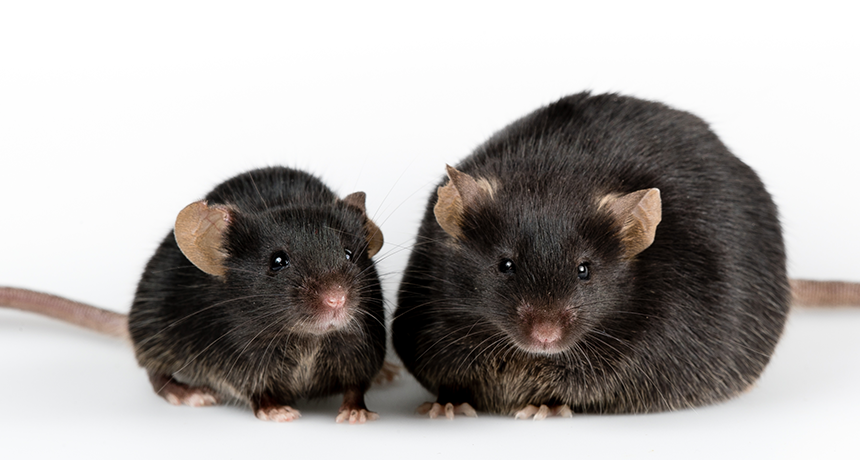Obesity in mice caused by defects in their immune system
Related changes to gut microbe mix and fat absorption may be at work in people as well

A study in mice showed altered immune cells led to weight gain. Gut microbes also played a role.
Georgejason/iStock/Getty Images Plus
A problem with an immune system gene may lead to obesity and type 2 diabetes, a study done in mice suggests.
Mice gained weight and developed health problems when they had a genetic defect that impairs some immune cells. The immune problems were linked to shifts in the gut microbiome. That’s the collection of friendly bacteria and other microbes living in the intestines. Altering the gut microbe mix could increase the amount of fat absorbed from food, researchers say. They reported their findings July 26 in Science.
More studies are needed to see if these findings hold up in humans. If so, it might be possible to boost a person’s immune system function. That might, in turn, help prevent obesity and related health problems.
People with obesity and those with type 2 diabetes also have an unusual gut microbe mix and immune system deficiencies. The people’s bacteria mixes are similar to those seen in the mice. And obese people’s immune systems don’t always work very well, says June Round. She’s a microbiome researcher who worked on the new study. She’s at the University of Utah School of Medicine. That’s in Salt Lake City. “It’s possible that things that are happening in our mice are also happening in individual [humans],” she says.
The researchers studied mice that had a defect in the Myd88 gene. That defects stops the mice from making the Myd88 protein in their T cells. T cells help the immune system recognize and kill bad bacteria and viruses.
The researchers noticed that the mutant mice started gaining weight at about 5 months old. By about a year old, those mice weighed up to 60 grams (about 2 ounces). That’s about twice as much as a normal mouse. The mutant mice also had a problem associated with obesity called insulin resistance. This is a condition in which the body’s cells can’t process dietary sugars efficiently. It is a hallmark of type 2 diabetes in people.
Gut microbes
Round and her team found that the mice had reduced activity of some T cells called T helper cells. The job of these helper cells is to tell other immune cells, called B cells, to make microbe-fighting antibodies. But in these mice, the B cells made less of these antibodies.
The researchers found that obese mice had fewer types of gut microbes compared to normal mice. There were lower numbers of Clostridia bacteria in the small intestine. And there were increased numbers of Desulfovibrio bacteria. That pattern also has been seen in obese people and people with type 2 diabetes.
Some Clostridia bacteria in the mutant mice were coated with many antibodies. This suggests those bacteria were targeted for destruction. But other Clostridia species had few antibodies clinging to them. Sometimes antibodies help bacteria instead of killing them. Clostridia with few antibodies might not grow well in the gut.
Desulfovibrio also was more heavily antibody-coated than usual. But the researchers aren’t sure how that might affect the bacteria’s growth.
Giving heavy mice more Clostridia led to weight loss. But the researchers couldn’t make normal mice overweight just by giving them Desulfovibrio. That’s probably because the immune system in normal mice can keep the bacteria in check, Round says.
Altered state
Altering the microbiome may affect how much fat is absorbed in the small intestine. Giving the mutant mice extra Clostridia reduced the production of a protein involved in fat absorption. But giving the mice Desulfovibrio had the opposite effect. It increased the protein’s production. This suggests that Clostridia protect against obesity. On the other hand, Desulfovibrio appear to promote obesity.
Scientists had known that both gut microbes and diet help to determine body weight. But the new study “shows that the immune system is really important in how that plays out,” says Lora Hooper. She’s a microbiologist and immunologist. She does research at the University of Texas Southwestern Medical Center. That’s in Dallas. She wasn’t involved in the study, but she co-wrote a commentary on the work in Science.
The work raises many questions, Hooper says. One of the biggest is why our microbiome is in charge of how much fat the gut absorbs. She doubts that Clostridia evolved to protect against obesity. That’s a modern-day problem. Instead, she thinks that maybe increased fat absorption evolved to deal with having too much of certain gut bacteria. The calories from the extra fat would give the body extra energy to fight the bacteria.







